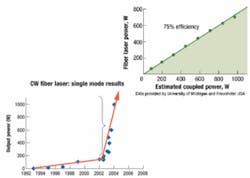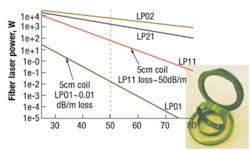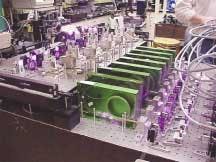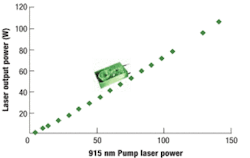By Adrian Carter
and Bryce Samson
Since the advent of cladding pump fiber designs in 1988, power scaling of fiber devices was limited by the availability of high-brightness pump radiation, rather than the fiber itself. This trend continued with the use of the available fiber technology, culminating in 1999 with the demonstration of the world’s first single-mode fiber laser that exhibited output in excess of 100-watts continuous wave (CW).
Scientists soon recognized that conventional small-core, high-numerical-aperture (NA) fiber designs were not appropriate for applications requiring further scaling of the output power. More specifically, they found that a fundamental susceptibility to optical nonlinearities - including stimulated Raman scattering (SRS), stimulated Brillouin scattering (SBS), and self-phase modulation - restricted the maximum achievable output power in such fibers.
To overcome the limitations that these parasitic nonlinear processes impose, experts have developed fibers with high lanthanide dopant concentrations in relatively large-core, low-NA fibers. These so-called large-mode-area (LMA) fibers are directly responsible for the recent explosion in demonstrated diffraction-limited beam quality output powers now approaching the kilowatt level from one fiber (see Figure 1). The advent of this new class of fibers places limits on the pump source once again, rather than on the fiber.
For most high-output-power applications, several unique advantages have made ytterbium (Yb) the dopant of choice. More specifically, ytterbium-doped fibers offer high output powers tunable over a broad range of wavelengths, from around 975 to 1200 nanometers (typically around 1060 nanometers).
Ytterbium also has a relatively small quantum defect; because the pump wavelength (typically 915-975 nanometers) is close to the lasing wavelength very little energy is lost to heating. Furthermore, unlike other lanthanide ions, ytterbium has only one excited state, is not subject to complications arising from excited- state absorption (ESA), and is relatively immune to self-quenching processes. Consequently, designers can incorporate high concentrations of ytterbium ions while maintaining excellent conversion efficiencies (typically greater than 75 percent). For this reason the industry has focused on the development of ytterbium-doped fibers.
One of the most significant keys to ensuring broad marketability of fiber lasers is the development of a technique for producing ever-increasing output powers without sacrificing beam quality. Naturally, it is possible to ensure diffraction-limited beam quality from a single-mode core in double-clad fiber geometry. Unfortunately, such a design also limits the total achievable output power and in pulsed laser devices the average power, peak power, and pulse energy.
These limitations are the result of low energy storage (for pulsed applications) and the effects of parasitic nonlinear processes. Determining energy storage capacity is a combination of the number of active species present and the maximum achievable population inversion. Determining the maximum achievable population inversion, in turn, reveals the likelihood of amplified spontaneous emission (ASE).
The power threshold for all these parasitic limitations rises significantly in the generation of highly doped LMA fibers. By increasing the core diameter of a fiber and reducing NA it is possible to maintain single-mode operation while reducing the fraction of spontaneous emission captured by the core and decreasing the power density in the fiber, thereby increasing the threshold power for the nonlinear processes.
Furthermore, the total number of active ions present, as well as the energy storage capacity, increases as the square of the core diameter for a given glass dopant concentration and cladding diameter. Consequently, it is possible to reduce the length of the fiber device, thereby further increasing the threshold for the nonlinear processes.
Of course, there is an upper limit to the core diameter beyond which single-mode operation is not guaranteed. At NAs lower than 0.06, furthermore, fibers begin to exhibit extremely high bend sensitivity, which imposes a practical lower limit on NA and hence an upper limit on core diameter. Fortunately, there are ways to suppress higher-order lasing modes that allow designers to use even larger core diameters wherein essentially multimode fibers can be made to operate with a diffraction-limited beam quality.
These techniques include suitably manipulating the fiber index and dopant profiles, using special cavity configurations, tapering the fiber ends, adjusting the seed launch conditions, and coiling the fiber to induce substantial bend loss for all transverse modes other than the fundamental.
Perhaps the simplest and least expensive of all these is the coiling technique. It does not require careful matching of the seed mode and does not rely on complex fiber designs. It is only necessary to choose the radius of curvature (based upon core diameter and NA) that will discriminate against high-order modes. The fundamental mode is the least sensitive to bend loss and the attenuation due to bend loss is exponentially dependant upon the bend radius, and coiling technique makes the most of this.
For example, Figure 2 shows the theoretical bend loss as a function of bend radius for a 0.06 NA, 30-micron-core-diameter fiber. Such a fiber in a linear configuration can support around five modes but with the appropriate choice of bend radius (say, around 50 mm) the LP11 experiences around 50 dB/m of attenuation (and higher-order modes are even more attenuated), while the LP01 mode experiences only around 0.01 dB/m. It is important to note that this technique does not involve the stripping of power from higher-order modes, but rather the suppression of those modes along the entire fiber length. As such, power is not attenuated and the efficiency of the laser device is not markedly reduced.
The ability to power scale fiber devices depends on two key criteria: pump power can be efficiently and cost effectively coupled into the fiber, and the fiber core parameters are such that it can convert this pump power into bright lasing or amplification without saturation or nonlinear processes that limit the performance.
One of the major advances in fiber technology in recent years has been the advent of large-mode-area (LMA) fibers, and the potential for these fibers to deliver diffraction-limited beam quality with mode-field areas greater than 10 times that for standard telecom type fibers. Companies without access to LMA fiber technology are essentially limited by nonlinear phenomenon such as SRS to the near-100-watt CW power regime.
It is common for companies to power scale laser output further by incoherently combining the outputs from several fiber lasers, sacrificing beam quality as the power increases. In addition to providing better beam quality than the alternative fiber-laser technologies, one fiber laser producing about 1 kilowatt will involve a less-expensive architecture than one based on combining the output from 10 100-watt fiber lasers, saving costs of components such as fiber and fiber Bragg gratings, as well as labor and packaging.
Single-fiber lasers have delivered output powers approaching 1.5 kilowatts and theoretical modeling suggests 10 kilowatts may be possible with the current fiber technology. Despite the impressive high-power results, they are still more than an order of magnitude below the level required for future weapons systems.
Programs aimed at combining multi-fiber devices in a coherent array have received significant attention recently, including wavelength or spectral beam combining, frequency locking of coupled fiber cavities, and coherent beam combining. Many of these research programs are aiming to scale up earlier demonstrations that typically consisted of combining usually less than 10 fairly low-power fiber lasers, each operating around 10 watts.
The experiments are targeting arrays more powerful than 1 kilowatt using 100-watt fiber elements. Future power scaling would then exceed 10 kilowatts through scaling of the individual array elements or by applying more relatively low-power elements, depending on the particular coherent array scheme. An example of such an experiment is shown in Figure 3.
Large cladding diameters
A critical advantage in high-power lasers is Nufern’s ability to deliver large-cladding-diameter fibers (typically 400 micron) with high NA to couple pump radiation efficiently. Advances in manufacturing of fiber-coupled bars and stacks have kept pace with the power scaling of the fiber laser, and Nufern large-clad fibers have been developed with this improving diode technology in mind. Fiber-coupled diode bars may become the dominant diode pump technology for solid-state laser applications because of price concerns. Fiber-laser architectures based on standard telecom-type fiber claddings (say, 130-micron diameter) are not compatible with this diode pump technology, but rather are used with the diodes based on individual single emitters, a technology that is currently more expensive than diode bars and stacks and forecasted to remain so in the foreseeable future.
Recent progress in a U.S. Defense Advanced Research Projects Agency (DARPA)-funded program with Alfalight (www.alfalight.com) to develop highly efficient diode pump technology achieved 71 percent power-conversion efficiency (PCE), well within sight of the final program goal of 80 percent PCE by September 2006. Clearly, fiber-laser technology delivering 75 percent power conversion efficiency in combination with a new generation of pump diode technology offers a path to high wall-plug-efficiency laser weapons systems for possible future airborne applications.
In addition, fiber-coupler manufacturers are providing a family of standard pump combiners that are compatible with the new LMA fiber technology, thus removing any barriers from the diode manufacturers to develop suitable pump modules. The strategy has enabled numerous diode vendors to address the growing fiber-laser market, ensuring future competition on diode pump sources and low-cost solutions for fiber-laser technology. An example of this is our 100-watt standard CW laser module (see Figure 4) that comes with a large number of diode pump options.
Polarization-maintaining fibers and amplifiers
It is not feasible to increase the output power capability of an LMA-DCF (double-clad fibers) indefinitely through scaling of the core diameter. Ultimately, there will be some upper limit above which output beam quality will begin to degrade. To help overcome this hurdle, researchers are working on refining the design of LMA-DCFs by optimizing the glass composition and waveguiding structure.
However, with the growing need for output powers of several kilowatts for industrial cutting and welding applications and greater than 100 kilowatts (CW) for military and aerospace applications, the goal of a number of research groups is to achieve diffraction-limited kilowatt powers from one fiber and then combine the outputs of several such devices. Such power-scaling techniques include coherent beam combining, spectral beam combining and polarization beam combining. For these extremely high-power applications, operation under stable linear polarization is becoming a requirement. Furthermore, a number of other applications require PM output including coherent optical communications, nonlinear frequency conversion, pumping optical parametric devices, and all manner of modelocked, Q-switched, and narrow-linewidth fiber lasers. Consequently, the demand for PM-DCFs has increased in recent years.
PM fibers rely on residual stress anisotropy across the core that arises from differences in thermal coefficient of expansion between the stress members and the core and cladding. The composition, location, and geometry of the stress members determine the birefringence in the fiber. The core and cladding geometries in PM-DCFs are very different from standard telecommunications-type PM fibers. More specifically, in LMA-DCFs the large diameter of the core hurts the achievable birefringence. Consequently, while passive polarization-maintaining fibers have been commercially available for many years, until recently actively doped PM fibers have not. In fact, an amplifier using ytterbium-doped PM-DCF was first reported in 2000, using Nufern fibers. If PM-LMA-DCFs were to be feasible, researchers had to find ways to optimize the compositional and the geometrical design of the stress members. In 2003 Nufern scientists reported the results of such detailed experimental and theoretical analyses.
For small-core single-mode fibers in low-to-medium-power applications, it is relatively easy to achieve sufficient birefringence using standard stress member compositions. However, for LMA-type fibers needed for high-power applications, achieving sufficient birefringence while operating within the manufacturing limits of stress rod size and location is far more challenging. In such cases, a higher coefficient of thermal-expansion difference, and hence higher birefringence, happens by adjusting the composition of stress members, similar to those used for gyroscope fibers. A broad range of ytterbium-doped LMA-DCFs optimized for a variety of output powers, are commercially available as standard products. An optical image showing the cross section of such a fiber, with a 20-micron core and 400-micron inner-cladding diameter is presented in Figure 5.
Nufern’s LMA-DCF fibers have a 0.46-NA fluorinated-polymer optical cladding surrounded by a more standard telecommunications-type jacket (for abrasion resistance). PM versions of these fibers offer slope efficiencies and operate at power stronger than 300 watts. Scientists discovered that the fiber and coil combination can be designed to make a novel high-power polarized fiber laser (see Figure 6). The design is typically manufactured for about the same cost as a random-polarized design.
FIGURE 6. Nufern’s proprietary technique for making a linear polarized fiber laser using the coiling-induced polarizing effect removes the need for external polarizing elements or extra elements in the cavity. Such architecture allows, for the first time, high-power PZ-fiber lasers to be made for around the same cost as a randomly polarized fiber lasers. Polarized output is critical for many nonlinear applications and makes isolation of the laser output significantly easier.
Eye-safe wavelengths
LMA fiber technology has made an equally dramatic impact on pulsed-fiber-laser technology, where pulse energies are approaching 100 millijoules with multimode beam quality and about 4-millijoule single-mode, corresponding to greater than 1-megawatt peak power. High peak powers with nanosecond-duration pulses and diffraction-limited beam quality are important for many applications involving target designation and laser radar.
Although most of the recent power scaling has occurred at the 1-micron wavelength using Yb-doped fibers, significant progress has also been obtained in power scaling Er:Yb (erbium:ytterbium)-codoped fibers at 1.55 micron and thulium (Tm)-doped fibers operating around 2 micron. Both of these are important “eye safe” wavelengths for military and civilian applications.
Because of the complexities of the glass composition and the rare-earth doping process, a true LMA fiber has not yet been developed for either of these systems. However, efficient devices with slope efficiencies in the 40- and 60-percent range have been reported for these two systems, respectively. In fact, a laser delivering about 120-watts peak power in quasi-CW operation and 53.8 percent slope efficiency has been reported at 2 micron. Also important, both these systems are compatible with high-power diode bars, which will help facilitate further power scaling as fiber technology develops.







